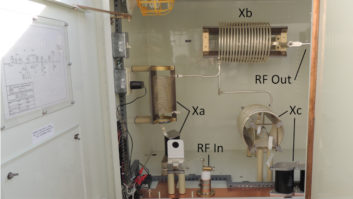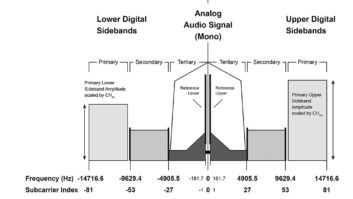Most radio engineers today will recall uncomfortable evenings and cold nights spent in dog houses making antenna impedance measurements, or worse, still trying to balance a laboratory model GR bridge on a freestanding steel ATU cabinet, adjust a signal generator or oscillator, tune a detector and probably try to take notes. The development of the operating impedance bridge by Delta Electronics about 40 years ago changed all that, and together with the receiver generator made antenna impedance measurements not only much easier to perform, but more accurate because antenna measurements can now be made under actual operating conditions. Almost inevitably measurements made with actual operating power, or at least sufficient power to produce operating conditions, are more accurate than cold measurements made using flea power.
OIB
The first version of the OIB was known as the OIB-1, and as it became widely used a few minor changes were made. Today the OIB-3 is very similar in appearance to the OIB-1 and is shown at left. Its impedance measuring range now covers from -1000 to +1000? resistance and -900 to +900 reactance to 1MHz. When the OIB was first introduced it became possible for the first time to measure circuit impedances under operating conditions at any point in the antenna system.

Remember that the bridge is calibrated at 1MHz and it is necessary to apply a correction to the reactance read directly on the reactance dial. Many years ago I found it was quite easy to forget to make this correction. However, with practice it becomes automatic. The actual correction is engraved on the panel of the instrument: X (corrected) = X/F. X = reactance (dial reading) and F = operating frequency in megahertz.
The OIB-3 is available in two versions. The first version measures up to 2MHz, and version 2 has an extended range to 5MHz. The operating ranges are identified by the bridge’s serial number. Serial numbers 001 through 1224 cover the broadcast band, and serial numbers 1225 and above tune higher. Two-range bridges have meter DIR/TUNE switches marked Tune HI and Tune LO. The high position extends the tuning range to 5MHz, which greatly increases its usefulness.
This instrument offers a choice of 12″ or 18″ connecting cables and comes with a coaxial adapter. I have always found the 18″ cables very useful when measurements have to be made in difficult areas using the transmitter as the power source (but not more than 5kW). Care should be taken to avoid contaminated measurements caused by random lead movements. Coaxial connectors are also available in the form of a large male UHF male-to-female PNC adapter. It is very important to ensure that both clip leads are properly grounded at the instrument input and output connections when used with an actual transmitter.
The OIB-3 requires only an RF power source to put it into action and has a built in detector and indicator so that additional equipment is not normally required when used with a transmitter RF power source. The built-in detector and tuning circuit usually provides adequate sensitivity when using a transmitter as an RF source.
VARIATIONS
When greater sensitivity is required, the built-in detector is tuned to the frequency of interest by using the detector tuning control for the appropriate frequency range. If still greater sensitivity is required the internal battery operated meter amplifier can be switched into use to provide increased sensitivity. In this case it is advisable to turn the sensitivity control toward minimum prior to switching on the meter amplifier. When an upscale reading is obtained, the appropriate tuning control should be adjusted for maximum deflection and a sharper null.

When measuring conditions result in very low RF power levels, an external detector can be connected via a double-shielded cable to the BNC connector on the OIB-3 panel. When a suitable receiver/generator, such as the Delta Electronics RG-4B (next page) is used for this purpose, it provides a convenient RF power source for the operation of the OIB-3 impedance bridge in situations lacking a transmitter RF source.
Because it is an operating impedance bridge, the OIB-3 can be inserted anywhere in the transmitter to antenna path with a maximum of 5kW RF power. Therefore the actual operating impedances can be measured under operating conditions, and individual tuned circuits can be measured and adjusted under operating power as necessary using the receiver generator as a source of RF signal.
When measuring impedances under transmitter power the line is opened and the cable end coming from the transmitter is connected to the IN connector on the side of the case. The OUT terminal of the OIB is connected to the interrupted line going to the load. When using transmitter power and a coaxial line is interrupted it is essential that the clip lead cables are properly grounded to the system. It is also worth mentioning that when the bridge is inserted into a coaxial line high accuracy is obtained by using coaxial adapters instead of clip leads. The instruction manual that comes with the bridge provides very clear and straightforward instructions for its general operation. It also provides an interesting explanation of the manner in which the OIB operates.
I have found the OIB-3 to be invaluable when working with antennas involving negative towers that are returning power to the system. Negative towers are very easily measured by merely reversing the connections to the OIB. In other words the power source (transmitter) is connected to the OUT terminal on the bridge and the RF load to the IN terminal. Bridge operation is the same as for positive towers and the measured impedance is read from the bridge dials. The operating load impedance will be read as a negative of the impedance measured. It should be noted that the resistance dial is calibrated below zero to about 5? on the minus side of zero. This eases the measurement of anticipated operating resistances near zero and eliminates the need to reverse the bridge connections when measuring negative towers.












